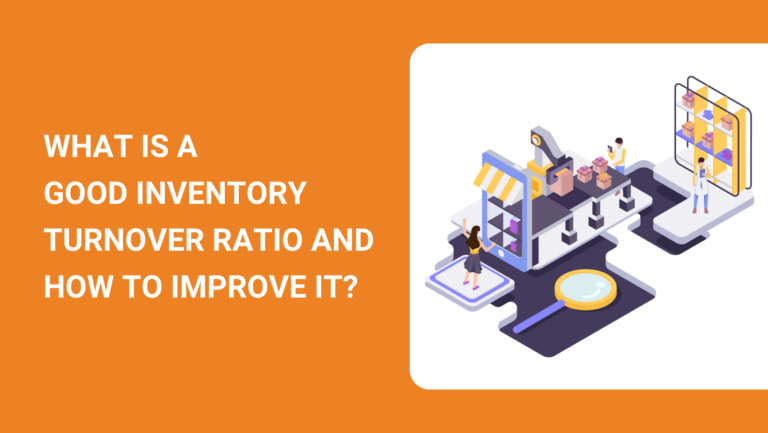Inventory management goes beyond the efficient storage of items in your warehouse. The core purpose of any business is to convert its inventory into profitable sales and timely restocking to fulfill repeat orders.
How fast your inventory is replenishing defines how quickly your business is growing. You need a mix of good pricing strategy, smooth reordering, and a flawless supply chain to achieve a good inventory turnover.
But what is a good inventory turnover ratio, how to calculate it, and why it is important for your business? You’re just about to learn this and much more in this insightful article.
Let’s dive in.
What Is the Inventory Turnover Ratio?
The inventory turnover ratio refers to how many times a company sells its complete inventory in a given period.

This tells us the speed with which the company is selling all of its items. In other words, if some items are selling well and others are not, it will be reflected in the ratio.
So, to achieve a good inventory turnover ratio, a company has to clear its dead stock.
If there are some slow-moving items in a company’s inventory on hand, they will also affect the ratio.
Therefore, a company will have a high inventory turnover ratio if all of its items are selling fast and a low ratio if the items are selling out too slow.
How to Calculate Inventory Turnover Ratio?
The formula to calculate the inventory turnover ratio is mentioned below.
Inventory Turnover Ratio = COGS/Average Inventory
COGS means the total cost of goods sold in the specified time.
Average inventory is calculated by taking an average of the starting inventory and the ending inventory in the specified time.
The formula for calculating the average inventory is given below.
Average Inventory = (Starting Inventory + Ending Inventory) / 2

Inventory Turnover Ratio Examples
You will get more clarity on the inventory turnover ratio with examples. Let’s discuss two examples below.
Example 1 – ABC Limited
ABC Limited is a company that sells multiple items online. It had an inventory of $2mn at the start of the year 2021 and an ending inventory of $6mn with $20mn as COGS for the year 2021.
Let’s calculate its inventory turnover ratio.
COGS = $20mn
Starting Inventory = $2mn
Ending Inventory = $6mn
Average Inventory = ($2mn+$6mn)/2 = $4mn
Inventory Turnover Ratio = $20mn/$4mn = 5
So, ABC Limited sold its complete inventory 5 times in 2021.
Example 2 – XYZ Limited
XYZ Limited is a company that sells artificial jewelry in its physical stores. It had an inventory of $5000 at the start of Q4 in 2021 and an ending inventory of $7000 with $36000 as COGS for the whole Q4 in 2021.
Let’s calculate its inventory turnover ratio.
COGS = $36000
Starting Inventory = $5000
Ending Inventory = $7000
Average Inventory = ($5000+$7000)/2 = $6000
Inventory Turnover Ratio = $36000/$6000 = 6
So, XYZ Limited sold its complete inventory 6 times in the Q4 of 2021.
How to Calculate Inventory Turnover in Days?
Inventory turnover in days refers to the number of days in which a company sells or restocks all of its inventory. It can be derived from the ratio.
Some companies prefer to calculate inventory turnover in days over the ratio. It’s simple math to convert inventory turnover ratio in days. The formula is given below.
Inventory Turnover Days = Number of Days in a given time/Inventory Turnover Ratio

For example, if we need to calculate the inventory turnover days of a company in a year, the formula will be as follows.
Inventory Turnover Days = 365/Inventory Turnover Ratio
Let’s calculate the inventory turnover days for both examples we discussed above.
Example 1.1 – ABC Limited
Inventory Turnover Ratio = 5
Number of Days in a given time = 365 days
Inventory Turnover Days = 365/5 = 73 days
So, it means that ABC Limited replenished all of its inventory in 73 days in 2021.
Example 2.1 – XYZ Limited
Inventory Turnover Ratio = 6
Number of Days in a given time (Q4) = 92 days
Inventory Turnover Days = 92/6 = 15.33 days
So, it means that XYZ Limited replenished all of its inventory in 15 days in Q4 of 2021.
What Is a Good Inventory Turnover Ratio?
No universal ratio can denote a good inventory turnover for every business. Every industry has different dynamics.

To compare your inventory turnover ratio, you should always do it with a successful company in your industry or more specifically, your niche.
Generally speaking, a high inventory turnover ratio calculated over a long period is considered good.
As a rule of thumb, an inventory turnover ratio from 4 to 6 is considered good in e-commerce.
Amazon had an inventory turnover ratio of 10.9 in 2019. But it would be unfair to compare your small e-commerce business with Amazon’s inventory turnover ratio since the latter has a huge mix of products that have different selling speeds.
Again, if you are comparing your inventory turnover ratio, compare it with the leading company in your niche and try to be at par with it.
Inventory Turnover Benchmark by Industry
The following turnover benchmarks by different industries in e-commerce may help you compare your inventory turnover ratio.
As per RapidRatios, the inventory turnover ratio for the retail industry is 10.86.
The inventory turnover ratios for a few e-commerce industries are mentioned below for your reference.
- Wholesale trade-durable goods – 21
- Clothing stores – 24
- Wood products – 13
- Computer equipment – 25
- Home improvement stores – 27
What Does the Inventory Turnover Ratio Tell You?
A company’s annual report includes the data about its inventory turnover in terms of ratio or days. It gives you many insights about a business.
It tells us how fast or slow a company is selling its products in comparison to another company.
So, it can hint at whether a company is growing or shrinking. But it is just one of the factors to decide if a company is good or bad. There are many other factors which we should consider.
Let’s discuss what the inventory turnover rate can tell you about a company.
What Does a High Inventory Turnover Ratio Tell You?
A high inventory turnover ratio tells you about the following points.
Speedy Sales
As discussed above, a high inventory turnover ratio tells us a company is selling its products fast in a given period.

Quick Restocking
A company with a high inventory turnover ratio needs to restock its items to keep the sales cycle running. If they cannot restock inventory timely, their ratio will gradually go down.
If the inventory turnover ratio is calculated over a longer period i.e., a year, it means a smooth restocking of that company.
Fast-Moving Goods
A high inventory turnover ratio also tells us about the nature of items sold by a company. As mentioned in the inventory turnover benchmark by industry, some e-commerce industries have a fast sales cycle. Hence, a higher ratio.
Clothing stores have a much higher inventory turnover ratio than wood products because of the high selling pace of clothes as compared to furniture.
Insufficient or Low Inventory
A high inventory turnover ratio can also tell us that a company has insufficient stock to meet the market’s demands. This can especially happen if the inventory turnover ratio is calculated over a short period.
So, you cannot always consider a company with a high inventory turnover ratio as a good company.
For example, a company that has calculated its inventory turnover ratio in Q4 only may depict a higher ratio.
That doesn’t mean that the company would be having that ratio throughout that year.
So, the period for which the inventory turnover ratio has been calculated is very important.
Better Forecasting
A higher inventory turnover ratio also means that the company needs better forecasting in the future to cope with unusual demands for its products.
A higher ratio throughout the year already means that the company had good forecasting to restock its sold items but it also gives the data for planning the future inventory levels ahead of time.
This can happen in the peak seasons. So, for better forecasting, the company needs to calculate the inventory turnover ratio of different periods (quarters or months) for better forecasting of their inventory.
On the other hand, they can also analyze the months they can hold on to their ordering due to slow sales.

What Does a Low Inventory Turnover Ratio Tell You?
A low inventory turnover ratio can tell us the following.
A Weak Business
The low inventory turnover ratio tells us that a business is not having enough orders.
There may be many reasons for it. It can mean that a business has just started or introduced new products into its existing line.
Nevertheless, it can also mean that a business is unable to achieve the required levels of sales.
Low Demand for the Products
A low inventory turnover ratio also means a low demand for the products in the given period.
For example, if a business sells items related to presidential elections, it will have a boost in sales every 4 or 5 years.
In that case, its annual inventory turnover ratio may be low. So, to calculate the right inventory turnover ratio for this business, the given period should be 4 or 5 years.
Slow-Moving Goods
Some consumer items have slow sales. A low inventory turnover ratio also tells us that the products have low levels of demand.
That doesn’t necessarily mean that the products are having bad sales.
Overstocking or Dead Stock
A low inventory turnover ratio can also tell you that your company may have overstocked a few or all the items. That’s why you are not selling your complete inventory in a short time.

In that case, you need to rethink your inventory levels. You should get rid of excess inventory and only have the required items that sell fast.
Why Do You Need to Measure Inventory Turnover?
As a business owner, you need to measure your company’s stock turnover for the following reasons.
- To evaluate your business success.
- To monitor your sales cycles at a given period.
- To make smarter decisions related to inventory.
- To develop a smoother supply chain process.
- To develop more effective marketing campaigns to improve your sales.
- To make more efforts to liquidate your stock on time.
- To do better forecasting and improve warehouse management.
- To develop a good rapport with your supplier and explore more suppliers for backup.
How to Improve Inventory Turnover?
A bad or low inventory turnover means a loss to your business. It keeps your investment stuck and doesn’t let your business grow.
In that case, you may have to work on your sales or inventory. You can consider taking the following steps to improve your inventory turnover.
Aggressive Marketing Campaigns
Try running the marketing campaigns that help sell your products. Advertise on social media and search engines to target a wide range of customers.
You can also try some sales-boosting tricks like mystery boxes and free shipping.
Avoid Overpricing
If you have set the prices too high, you may have poor sales. In e-commerce, customers often check the prices of the same products from different sources before buying.
That’s why you must source products at the right prices to set realistic and competitive retail prices.
Offer Discounts
Customers love discounts. Try offering crazy discounts on your products as compared to your competitors.
You should utilize special events like Black Friday, Christmas, New Year, etc. to maximize your sales.
Improve SEO
Sometimes, people are unable to reach your website or store even if they need your products just because your website does not show up in the search results.
If you improve the SEO of your website and include the right search terms or keywords in your website’s content, you will get more organic sales.

Get Rid of Old or Dead Stock
Old stock or dead stock is a disaster for inventory turnover. It holds your investment, disturbs the cash flow, and occupies a long-term space in your warehouse.
Even if you are having good sales of other items, dead stock prevents you from having a good inventory turnover ratio.
You may consider getting rid of dead stock even if you have to sell it on a breakeven.
Change the Type of Products
If you had a bad experience selling one type of product last year, try switching to the products that sell well.
Improve Your Forecasting
If bad forecasting is preventing you from having a good inventory turnover ratio, you should immediately implement a better strategy.
Keep a close check on your inventory management software to monitor your remaining SKUs and act before time.
Efficient Restocking
Using the forecasting data, you should never delay the reordering process. This is crucial in improving the inventory turnover ratio.
Have Backup Suppliers
If your current supplier delays your shipments, you are advised to have more suppliers in the backup.
This way, you’ll have the option to negotiate shipping times and other things.

FAQs about Inventory Turnover Ratio
The following answers to the frequently asked questions will clarify the doubts about the concept of inventory turnover ratio.
What Affects the Inventory Turnover Ratio?
In addition to the factors discussed in this article, the following factors also affect the inventory turnover ratio.
- Market’s trend – some products have a very high trend for a short time.
- Demand cycles – one-off demand vs regular and repeat orders.
- New technology – introduction of better versions of the products.
What if inventory Turnover Is Too High?
If the inventory turnover is too high, the company is having very fast sales or very low inventory levels in a given time.
The first scenario is desirable for a company but the second one can be a disaster.
How to Calculate Gross Profit with Inventory Turnover Ratio?
The formula to calculate the gross profit is mentioned below.
Gross Profit = Total Sales – COGS
We can get the value of COGS from the inventory turnover formula.
If a company has a total sales of $50,000 and its COGS is $35,000, its gross profit would be $15,000.
Why Do We Take Average Inventory to Calculate Inventory Turnover Ratio?
Sometimes, a company may experience unusual sales. For example, a company may have high sales selling seasonal items during peak seasons or low sales in other circumstances.
If we calculate the inventory turnover ratio during peak season, the ratio will be very high but that will not depict the true picture.
That’s why we take the average inventory to compensate for such ups and downs in a company’s sales in a given time.
Summary
A business buys inventory to sell it to its customers. Anything coming in the way has to be dealt with immediately.
For a successful business, you must always strive to liquidate your stock while still being profitable at all times. The inventory turnover in ratio or days is to validate whether a business is on the right track or not.
Do you want to improve your inventory by sourcing from the best suppliers at the most affordable prices? Ask for a free quote today and let us help you with that.

